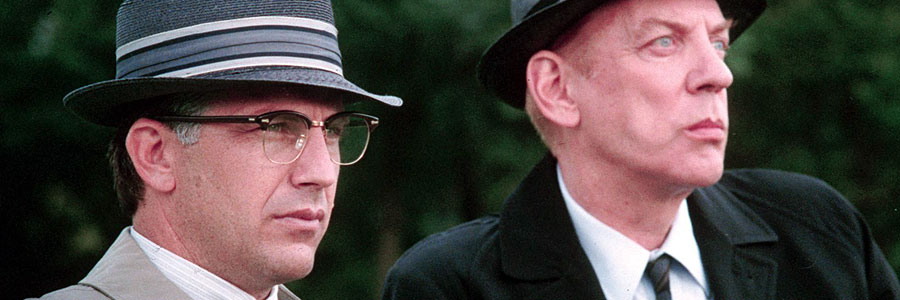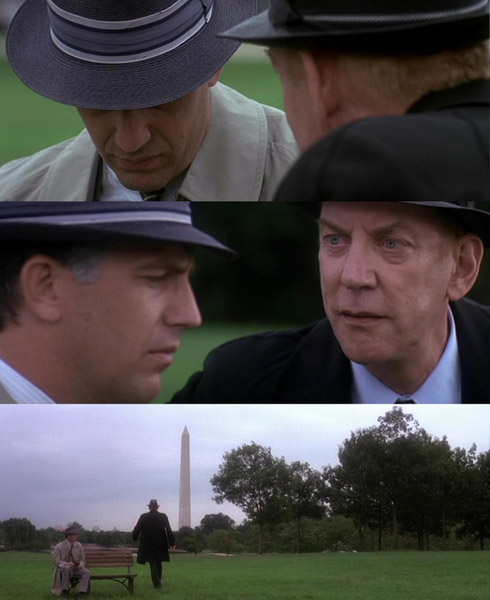
JFK
Warner Brothers
Original release: December 20, 1991
Running time: 189 minutes
Director: Oliver Stone
Writers: Oliver Stone, Zachary Sklar, Jim Garrison, Jim Marrs
Composer: John Williams
Narrator: Martin Sheen
Cast: Kevin Costner, Gary Oldman, Kevin Bacon, Tommy Lee Jones, Laurie Metcalf, Michael Rooker, Joe Pesci, Jay O. Sanders, Donald Sutherland, John Candy, Sissy Spacek
Lincoln Memorial: 01:45:21 to 02:02:13
Deconstructing Cinema: One Scene At A Time, the complete series so far

~ Alphonse de Lamartine
Today people will sometimes ask “Where were you on September 11th?” but before that it used to be “Where were you when Kennedy was shot?” Events that define the course of history are seldom positive, but it’s the moments that leave a stain we view and judge history by and November 22nd, 1963 left behind something we can’t wipe clean. Those in power, even half a century later, are still unwilling to admit that stain goes far deeper than it first appears.
The generally favoured version of events is that a lone gunman: Lee Harvey Oswald shot Kennedy from the 6th floor window of the Texas School Book Depository in Dallas as the president’s motorcade made its way down Elm Street. Later arrested, Oswald was then shot live on television by nightclub owner, Jack Ruby – also acting alone, as he was being transported from police headquarters to the county jail.
During the 10-month long investigation, the Kennedy assassination was played out like an open and shut case by the Warren Commission for the American public, but Stone’s film explored a far wider area than what was contained in those 888 pages. Accused of focusing on conspiracy theories by the media, JFK revisited testimonies that were altered, deleted or altogether fabricated during the official investigation to support the lone gunman story. Using On the Trail of the Assassins by Jim Garrison and Crossfire: The Plot That Killed Kennedy by Jim Marrs to build his screenplay, what Stone emerged with was a thorough investigation into the plot to kill Kennedy and then cover it up, tearing serious holes in the Warren Commission.

It was only recently that I realised to watch JFK is to catch a glimpse of how the world might really work, not just then but today as well. Although initially disappointed with Stone’s adaptation of events on September 11, 2001 with World Trade Center (2006), I found everything he could have included was actually right here in JFK.
The modus operandi and the suspects remain essentially the same and this is best represented than in a scene where New Orleans district attorney Jim Garrison (Kevin Costner) meets with a mysterious informant known only as “X” (Donald Sutherland). By far he’s the most intriguing character in this whole story despite his brief appearance, but Sutherland paces him well with his 15 pages of dialogue in just over 17 minutes, which is how long this scene lasts.
X was based on the real-life L. Fletcher Prouty (1917-2001), a retired colonel of the U.S. Air Force who served as the chief of special operations for the Joint Chiefs of Staff during the Kennedy years. Prouty was directly in charge of the global system designed to provide military support for the clandestine activities of the CIA. In an interview with radio host and author Gary Null that was published in The Grassy Knoll Witnesses: Who Shot JFK? by Harry A. Yardum, Prouty was asked if the character was indeed based on him:
Stone too was asked about X and in an interview published in Oliver Stone: Interviews by Charles L. P. Silet, he says:

In the film, X and Garrison’s meeting takes place at the Lincoln Memorial in Washington D.C. As their discussion begins Garrison is at first suspicious of who the man is and who he represents but there’s something about him which puts these worries aside, something that says he can be trusted and what he has to say is important. Garrison listens to X as he carefully recounts where he’s been and what he’s done before telling him, and us, where he was when he heard Kennedy had been shot.
Garrison continues to listen as X informs him that a “stand down” order was given to the 112th Military Intelligence Group at 4th Army Headquarters at Fort Sam Houston so they were unable to arrange for additional security in Texas for the president.
There’s more though. I listened to X describe in detail the amount of coincidences that had to be in place for such an attempt to be successful. As I did so it dawned on me how another set of amazing coincidences had to be placed on the morning of September 11th for a different series of attacks.

Army Intel had a “Harvey Lee Oswald” on file, but all those files have been destroyed. Many strange things were happening that day, and Lee Harvey Oswald had nothing to do with them. We had the entire Cabinet on a trip to the Far East. We had a third of a combat division returning from Germany in the air above the United States at the time of the shooting, and at 12:34 P.M., the entire telephone system went dead in Washington for a solid hour, and on the plane back to Washington, word was radioed from the White House Situation Room to Lyndon Johnson that one individual performed the assassination.
Does that sound like a bunch of coincidences to you, Mr. Garrison? Not for one moment. The cabinet was out of the country to get their perception out of the way. The troops were in the air for possible riot control. The phones didn’t work to keep the wrong stories from spreading if anything went wrong with the plan. Nothing was left to chance. I bet you there were even backup teams and cars on the other side of the underpass in the event that Kennedy got through wounded. They would have moved in with vehicles like they did with de Gaulle. He could not be allowed to escape alive.
The camera is on Garrison. This information is much greater than he ever envisioned, and he’s stunned. But he’s not the only one. I wondered then, from everything I had read on Mohammed Atta, one of the alleged hijackers and supposed ringleader in the September 11th attacks, and even Timothy McVeigh, the once alleged lone bomber in the Oklahoma City bombing on April 19, 1995, could they have been government assets and then set up as patsies? If the Kennedy assassination was an inside job, then couldn’t those attacks have been as well? But why?
That’s the real question, isn’t it – “Why?” – the “how” is just “scenery” for the suckers …Oswald, Ruby, Cuba, Mafia, it keeps people guessing like a parlor game, but it prevents them from asking the most important question – Why? Why was Kennedy killed? Who benefited? Who has the power to cover it up?
In these 17 minutes Stone sums up the history of the western world in politics and warfare with dialogue taken right from Prouty’s mouth. He’s created a mythical meeting that never actually took place but in a world where false flag operations are designed and carried out to keep the public in a state of constant fear against non-existent enemies, there’s little doubt in my mind to the validity of the discourse that takes place between X and Garrison. Stone knew it then and he knew it in 2005 when he began work on World Trade Center but chose a narrative instead that supported the official story rather than one that would kill his movie this time round.
The question isn’t who killed Kennedy, who blew up the Murrah Federal Building or who staged the grand spectacle of 9/11, but rather why, who benefited and who could have covered it up?

Let’s for a moment return to what Prouty has to say:
Prouty goes on to say that President Lyndon B. Johnson, during an interview with Leo Janos for Atlantic Monthly in July 1973, mentioned something quite extraordinary:
But third – and here he really said what answers your question. He said: “WE”, meaning the United States Government – “We maintain a Murder Incorporated,” and he added the words, “in the Caribbean” because that was pertinent to the questions that were going on. But this “Murder Incorporated” is Worldwide. And now the United States government maintains a “Murder Incorporated” capability, as we see, from time to time, when assassins or other tragic terrorist movements (covert operations) take place. The people who do that are professionals. And they work for certain elements of the United States Government.”
The murder is carried out, but that’s the easy part. The hard part is what comes next, duping the public into believing something else. That involves completely shifting their mindset from everything they knew and believed to be true and dear up until that moment.
SOURCES:
- Silet, C.L.P. Oliver Stone: Interviews (2001) Roundhouse Publishing Ltd
- Stone O., Sklar Z. JFK: The Book of the Film (1996) Applause Theatre Book Publishers
- Yardum, H.A. The Grassy Knoll Witnesses: Who Shot JFK? (2009) AuthorHouse
Now I’m sure if you got this far you’re thinking “WHAT?!” and the information together with the scene dissection I’ve presented here goes against everything you’ve heard from the news regarding all three events (Dallas, Okalahoma and New York) but I hope that what I’ve assimilated here might persuade at least one person when looking at such tragedies and acts of violence to start with the real questions: Why? Who benefited? Who has the power to cover it up?
The organizing principle of any society, Mr. Garrison, is for war. The authority of the state over its people resides in its war powers. Kennedy wanted to end the Cold War in his second term. He wanted to call off the moon race and cooperate with the Soviets. He signed a treaty to ban nuclear testing. He refused to invade Cuba in 1962. He set out to withdraw from Vietnam. But all that ended on the 22nd of November, 1963.
History has a funny way of repeating itself, maybe not in exactly the same way but if you ask the right questions and begin to look closely, especially with a film like JFK, you’ll see the same M.O. and the usual suspects time and time again. Garrison watches X walk away, vanishing into horizon towards the Washington Monument. Politics is power. Nothing more.

Patrick Samuel & Jonahh Oestreich
Patrick and Jonahh are the Editors in Chief at Static Mass.
Patrick is a composer and music producer with a philosophy degree. Static Mass is where he lives his passion for film and writing about it. A fan of film classics, documentaries and World Cinema, Patrick prefers films with an impeccable way of storytelling that reflect on the human condition.
Jonahh is a photographer and journalist who has been working in the media industry for over 15 years, mainly in television, design and art. As a boy, he made his first short film with an 8mm camera and the help of his father. His obsession with (moving) images and stories hasn’t faded since.
© 2022 STATIC MASS EMPORIUM . All Rights Reserved. Powered by METATEMPUS | creative.timeless.personal. | DISCLAIMER, TERMS & CONDITIONS
HOME | ABOUT | CONTACT | TWITTER | GOOGLE+ | FACEBOOK | TUMBLR | YOUTUBE | RSS FEED
CINEMA REVIEWS | BLU-RAY & DVD | THE EMPORIUM | DOCUMENTARIES | WORLD CINEMA | CULT MOVIES | INDIAN CINEMA | EARLY CINEMA
MOVIE CLASSICS | DECONSTRUCTING CINEMA | SOUNDTRACKS | INTERVIEWS | THE DIRECTOR’S CHAIR | JAPANESE CINEMA





